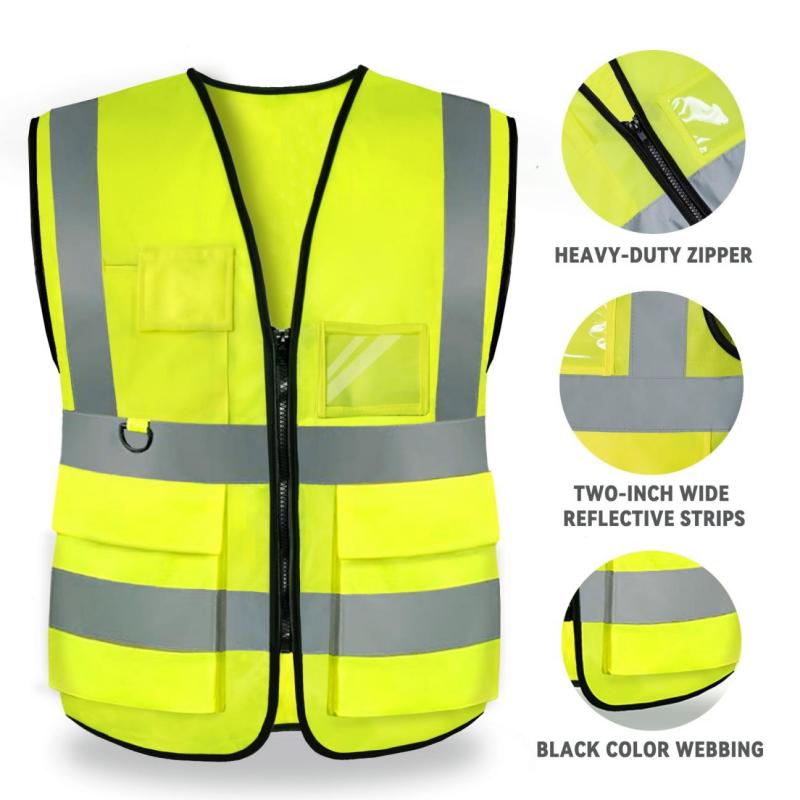Reflective Vests: Enhancing Visibility and Safety on Every Job
Ensuring workplace safety is crucial across all industries, safeguarding employees’ well-being and preventing accidents. Visibility plays a pivotal role in maintaining a safe working environment, particularly in areas with heavy traffic, machinery, or limited lighting. Reflective vests are indispensable for enhancing safety by increasing workers’ visibility to others, thereby reducing accident risks and enhancing overall situational awareness. These vests utilize highly reflective materials that capture light, including from sources such as headlights, ensuring workers remain conspicuous under various conditions. By wearing reflective vests, employees are easily spotted, significantly enhancing their safety while on duty.

The Significance of Visibility in Work Environments
Impact of Poor Visibility on Workplace Safety
Visibility stands as a pivotal factor in workplace safety, evidenced by statistics revealing a significant proportion of accidents linked to inadequate visibility. According to the Occupational Safety and Health Administration (OSHA), approximately 15% of workplace fatalities result from incidents directly related to poor visibility. This underscores the critical need for measures ensuring workers’ visibility, particularly in environments like construction sites and warehouses where risks are heightened.
Regulatory Requirements and Standards
Stringent workplace safety regulations necessitate the adoption of high-visibility clothing across various industries. OSHA and other regulatory bodies mandate that employers furnish employees with appropriate high-visibility gear, especially in sectors where visibility is compromised. These regulations are designed to safeguard workers and compel employers to take proactive steps in mitigating risks associated with poor visibility.
Benefits of High-Visibility Clothing
Beyond regulatory compliance, high-visibility clothing such as reflective vests offers multifaceted benefits. These garments significantly enhance worker visibility, thereby reducing accident risks and bolstering overall workplace safety. By increasing the likelihood of workers being seen, these vests also contribute to improved confidence and productivity among employees. Moreover, they facilitate better teamwork and communication by facilitating easier identification of colleagues in various work settings.
Andanda’s Advanced Reflective Vests
Design and Components Overview
Andanda’s reflective vests are engineered to prioritize worker safety through enhanced visibility. Crafted from advanced materials that effectively reflect light, these vests ensure wearers remain conspicuously visible. Key features include protection against splashes of liquids, a high-efficiency particle barrier blocking over 99% of solid particles, and an ergonomic design tailored to accommodate diverse body types for maximum comfort and usability.
Mechanisms for Enhanced Visibility
The reflective materials integrated into Andanda’s vests operate by efficiently reflecting light back to its source, thereby significantly increasing wearer visibility in all lighting conditions. These materials are designed to be breathable, ensuring comfort during prolonged wear, and boast quick-dry properties that maintain the vest’s lightweight feel. Additionally, their crease-resistant nature ensures durability and continued effectiveness throughout their lifespan.
Applications and Industries Utilizing Reflective Vests
Biopharmaceutical Sector
In environments handling hazardous materials, such as biopharmaceutical facilities, reflective vests play a crucial role in maintaining worker visibility amidst protective gear that might obscure their presence. This ensures safety protocols are adhered to without compromising visibility.
Agricultural Spraying Operations
Reflective vests are indispensable for agricultural workers engaged in spraying activities, particularly in low-light conditions. By enhancing visibility, these vests mitigate risks associated with machinery operation and improve overall safety on the field.

Warehousing and Logistics Centers
Reflective vests are integral in the bustling environments of warehouses and logistics centers, where heavy machinery and constant movement pose significant risks. These vests enhance worker visibility, thereby promoting both safety and operational efficiency.
Automotive Industry
Within the automotive sector, reflective vests are essential for workers involved in vehicle assembly and maintenance tasks. They ensure that workers are visible to their colleagues, particularly in dimly lit areas of manufacturing facilities.
Chemical Processing Facilities
Chemical treatment plants require stringent safety measures, and reflective vests are instrumental in maintaining high visibility for workers handling potentially dangerous chemicals. This visibility ensures quick identification in emergency situations, enhancing overall safety protocols.
Cleanroom Environments
In dust-free or cleanroom settings, reflective vests are critical for maintaining worker visibility without compromising the sterile conditions necessary for operations. They enable personnel to be easily identified while adhering to stringent cleanliness standards.
Electronics Manufacturing
Reflective vests play a vital role in electronic processing plants where intricate tasks with delicate components are commonplace. By ensuring worker visibility, these vests promote safety and facilitate effective coordination among team members.
Features and Design Considerations
Durability and Material Choices
When choosing reflective vests, durability and material quality are paramount. Opt for vests crafted from heavy-duty polyester or nylon, as these materials are resilient against wear and tear. They ensure prolonged safety by maintaining reflective properties over time, crucial for visibility in challenging work environments.
Comfort and Fit for Different Body Types
Comfort and fit play a crucial role in ensuring consistent wear of reflective vests. Look for ergonomic designs that accommodate diverse body shapes. Adjustable straps and a range of sizes ensure a comfortable fit, enabling unrestricted movement and reducing discomfort during extended wear.
Additional Features Like Pockets, Closures, and Ventilation
Reflective vests often include features that enhance functionality. Convenient pockets provide storage for tools and personal items, while secure closures like zippers or Velcro keep the vest securely in place. Ventilation systems, such as mesh panels, enhance breathability, ensuring comfort in varying temperatures and encouraging regular use.
Maintenance and Care Tips
Cleaning and Washing Instructions
Maintain reflective vests regularly to prolong their effectiveness. Follow manufacturer guidelines for cleaning, typically involving gentle washing in cold water with mild detergent. Avoid bleach and high-heat drying to prevent damage to the fabric and reflective strips, preserving their visibility-enhancing properties.
Inspection for Wear and Tear
Regularly inspect reflective vests for signs of wear and tear that could compromise safety. Look for fraying edges, fading reflective materials, or damage to closures. Promptly address any issues by repairing minor damages or replacing the vest to maintain optimal safety standards.
Replacement Guidelines Based on Usage
Replace reflective vests periodically based on their usage and condition. In high-use environments, consider replacing vests every six months to a year to ensure continued effectiveness. Immediately replace vests showing significant wear or reduced visibility to uphold safety for wearers.
Choosing the Right Reflective Vest
Factors to Consider: Job Environment, Visibility Requirements, Regulations
Selecting the appropriate reflective vest involves assessing specific job requirements and safety regulations. Consider the work environment—such as construction sites, warehouses, or road work—each with unique visibility needs. Ensure the vest meets relevant industry standards and provides adequate visibility for the tasks performed.
Tips for Selecting the Appropriate Class of Reflective Vest
Reflective vests are classified by visibility level and intended use. Class 1 vests are suitable for low-risk environments, while Class 2 offers moderate-risk coverage, and Class 3 provides maximum visibility for high-risk conditions. Choose the class that aligns with the risk level of the work environment to optimize safety.
Customization Options and Branding Considerations
Andanda customized reflective vests with branding and tailored features. Options include adding company logos, selecting specific colors, or integrating additional pockets. Customized vests not only enhance safety but also promote corporate identity and team cohesion among employees.
Equip Your Team with Our High-Quality Reflective Vests Today!
Reflective vests play a crucial role in improving visibility and safety across industries. With their durable materials, ergonomic designs, and additional features, they cater to diverse work environments effectively. It’s essential to maintain these vests regularly and replace them promptly to uphold their effectiveness. Selecting the appropriate vest based on job demands and safety regulations helps mitigate accident risks significantly. Customization options not only boost safety but also reinforce corporate identity. Investing in high-quality reflective vests proactively enhances employee well-being and fosters safer workplaces overall.

